Periodic Open Cellular Structures (POCS) as Catalyst Supports—A Review
Abstract
1. Introduction
2. POCS Characterization
2.1. Definition
2.2. Classification
2.3. Types
2.3.1. POCS for Solid Foam Characterization
- (a)
- Cubic cell
- (b)
- Kelvin cell
- (c)
- Dodecahedron cell
- (d)
- Weaire–Phelanc cell
2.3.2. Other POCS Geometries
2.4. Properties
3. POCS Design and Manufacturing
3.1. CAD + CFD Modeling
- (1)
- Selection of RUC in terms of the number of struts b and nodes j on the basis of desired mechanical behavior (stretching- or bending-dominated);
- (2)
- Tuning the relative density of RUC by changing b and/or strut diameter ds (if the strut length ls is constant);
- (3)
- Tuning the strut and node arrangement taking under consideration the load direction;
- (4)
- Tuning the RUC geometry changing the amplitude of angles between the struts in relation to the load direction and its intensity.
- (1)
- Minimum and maximum length of the struts;
- (2)
- Minimum and maximum thickness of the struts;
- (3)
- The sloping angle of the struts.
- (1)
- The optimum unit cell can be selected based on the following classification:
- Tessellation (periodic, stochastic, hierarchical)—the division of space into smaller, repeating entities;
- Elements (beam, surface)—the material constituents of the space;
- Connectivity (edge, face, vertex)—the ways in which the constituents are connected;
- (2)
- the size of the cells and their distribution—the lower bound of the cell size is defined by manufacturing constraints (e.g. resolution) and the need for powder removal, while the upper bound may be defined by the maximum overhang distance; the distribution means gradients; however, most commercial design tools leave these problems to the user and perform optimization at the level of the cell parameters;
- (3)
- the optimal cell parameters—the dimensions (geometric parameters, e.g., length, thickness, junction) and material composition of the cell;
- (4)
- the cell integration with the larger form—a uniform infill may be used that assumes the replacement of the larger component by the cellular material with no remnant skin or the cell trimming by a skin.
3.2. Additive Manufacturing
4. POCS Applications in Processes
5. Conclusions
Funding
Data Availability Statement
Conflicts of Interest
Nomenclature
| b | number of struts |
| j | number of nodes |
| M | Maxwell criterion |
| Shortcuts | |
| AM | additive manufacturing |
| CAD | computer-aided design |
| CFD | computational fluid dynamics |
| FCC | face-centered cube |
| MSLS | mesoscale lattice structure |
| POCS | periodic open cellular structure |
| PPI | pores per inch |
| RUC | representative unit cell |
| SEBM | selective electron beam melting |
| SLM | selective laser melting |
| TTKD | tetrakaidecahedron |
References
- Tang, H.-Y.; Erickson, P.; Yoon, H.C.; Liao, C.-H. Comparison of steam and autothermal reforming of methanol using a packed-bed low-cost copper catalyst. Int. J. Hydrog. Energy 2009, 34, 7656–7665. [Google Scholar] [CrossRef]
- Yang, J.; Wang, Q.; Zeng, M.; Nakayama, A. Computational study of forced convective heat transfer in structured packed beds with spherical or ellipsoidal particles. Chem. Eng. Sci. 2010, 65, 726–738. [Google Scholar] [CrossRef]
- Williams, J.L. Monolith structures, materials, properties and uses. Catal. Today 2001, 69, 3–9. [Google Scholar] [CrossRef]
- Cybulski, A.; Moulijn, J.A. Monoliths in heterogeneous catalysis. Catal. Rev.-Sci. Eng. 1994, 36, 179–270. [Google Scholar] [CrossRef]
- Rossomando, B.; Meloni, E.; De Falco, G.; Sirignano, M.; Arsie, I.; Palma, V. Experimental characterization of ultrafine particle emmisions from a light-duty diesel engine equipped with a standard DPF. Proc. Combust. Inst. 2020, 38, 5695–5702. [Google Scholar] [CrossRef]
- Iwaniszyn, M.; Ochońska, J.; Jodłowski, P.J.; Knapik, A.; Łojewska, J.; Janowska-Renkas, E.; Kołodziej, A. Short-channel structured reactor as a catalytic afterburner. Top. Catal. 2013, 56, 273–278. [Google Scholar] [CrossRef]
- More, H.; Mmbaga, J.; Hayes, R.E.; Votsmeier, M.; Checkel, M.D. Heat and mass transfer limitations in pre-turbocharger catalyst. Top. Catal. 2007, 42, 429–432. [Google Scholar] [CrossRef]
- Ahlström-Silversand, A.F.; Odenbrand, C.U.I. Modelling catalytic combustion of carbon monoxide and hydrocarbons over catalytically active wire meshes. Chem. Eng. J. 1999, 73, 205. [Google Scholar] [CrossRef]
- Lyubovsky, M.; Karim, H.; Menacherry, P.; Boorse, S.; LaPierre, R.; Pfefferle, W.C.; Roychoudhury, S. Complete and partial catalytic oxidation of methane over substrates with enhanced transport properties. Catal. Today 2003, 83, 183. [Google Scholar] [CrossRef]
- Porsin, A.V.; Kulikov, A.V.; Dalyuk, I.K.; Rogozhnikov, V.N.; Kochergin, V.I. Catalytic reactor with metal gauze catalysts for combustion of liquid fuel. Chem. Eng. J. 2015, 282, 233–240. [Google Scholar] [CrossRef]
- Jodłowski, P.J.; Kryca, J.; Rogulska, A.; Gil, B.; Iwaniszyn, M.; Łojewska, J.; Kołodziej, A. New method of determination of intrinsic kinetic and mass transport parameters from typical catalyst activity tests: Problem of mass transfer resistance and diffusional limitation of reaction rate. Chem. Eng. J. 2017, 162, 322–331. [Google Scholar] [CrossRef]
- Giani, L.; Groppi, G.; Tronconi, E. Mass-Transfer Characterization of Metallic Foams as Supports for Structured Catalysts. Ind. Eng. Chem. Res. 2005, 44, 4993–5002. [Google Scholar] [CrossRef]
- Peng, W.; Xu, M.; Li, X.; Huai, X.; Liu, Z.; Wang, H. CFD study on thermal transport in open-cell metal foams with and without a washcoat: Effective thermal conductivity and gas-solid interfacial heat transfer. Chem. Eng. Sci. 2017, 161, 92–108. [Google Scholar] [CrossRef]
- Bianchi, G.; Schwieger, W.; Freund, H. Assessment of Periodic Open Cellular Structures for Enhanced Heat conduction in Catalytic Fixed-Bed Reactors. Adv. Eng. Mater. 2016, 18, 608–614. [Google Scholar] [CrossRef]
- Kumar, P.; Topin, F. Simultaneous determination of intrinsic solid phase conductivity and effective thermal conductivity of Kelvin like foams. Appl. Therm. Eng. 2014, 71, 536–547. [Google Scholar] [CrossRef]
- Ranut, P. On the effective thermal conductivity of aluminum metal foams: Review and improvement of the available empirical and analytical models. Appl. Therm. Eng. 2016, 101, 496–524. [Google Scholar] [CrossRef]
- Bracconi, M.; Ambrosetti, M.; Maestri, M.; Groppi, G.; Tronconi, E. A systematic procedure for the virtual reconstruction of open-cell foams. Chem. Eng. J. 2017, 315, 608–620. [Google Scholar] [CrossRef]
- Gancarczyk, A.; Iwaniszyn, M.; Piątek, M.; Korpyś, M.; Sindera, K.; Jodłowski, P.J.; Łojewska, J.; Kołodziej, A. Catalytic Combustion of Low-Concentration methane on Structured Catalyst Supports. Ind. Eng. Chem. Res. 2018, 57, 10281–10291. [Google Scholar] [CrossRef]
- Bienvenu, Y. Application and future of solid foams. Comptes Rendus Phys. 2014, 15, 719–730. [Google Scholar] [CrossRef]
- Richardson, J.T.; Remue, D.; Hung, J.-K. Properties of ceramic foam catalyst supports: Mass and heat transfer. Appl. Catal. A Gen. 2003, 250, 319–329. [Google Scholar] [CrossRef]
- Bhattacharya, A.; Calmidi, V.V.; Mahajan, R.L. Thermophysical properties of high porosity metal foams. Int. J. Heat Mass Transf. 2002, 45, 1017–1031. [Google Scholar] [CrossRef]
- Kumar, P.; Topin, F. State-of-the-Art of Pressure Drop in open-Cell Porous Foams: Review of Experiments and Correlations. J. Fluids Eng. 2017, 139, 111401-1–111401-13. [Google Scholar] [CrossRef]
- Inayat, A.; Freund, H.; Zeiser, T.; Schwieger, W. Determining the specific surface area of ceramic foams: The tetrakaidecahedra model revised. Chem. Eng. Sci. 2011, 66, 1179–1188. [Google Scholar] [CrossRef]
- Kumar, P.; Topin, F.; Vicente, J. Determination of effective thermal conductivity from geometrical properties: Application to open cell foams. Int. J. Therm. Sci. 2014, 8, 13–28. [Google Scholar] [CrossRef]
- Gibson, L.J.; Ashby, M.F. Cellular solids: Structure and Properties, 1st ed.; Cambridge University Press: Cambridge, UK, 1988. [Google Scholar]
- Tamburrino, F.; Graziosi, S.; Bordegoni, M. The Design Process of Additively Manufactured Mesoscale Lattice Structures: A Review. J. Comput. Inf. Sci. Eng. 2018, 18, 040801. [Google Scholar] [CrossRef]
- Nazir, A.; Abate, K.M.; Kumar, A.; Jeng, J.-Y. A state-of-the-art review on types, design, optimization, and additive manufacturing of cellular structures. Int. J. Addit. Manuf. Technol. 2019, 104, 3489–3510. [Google Scholar] [CrossRef]
- Tao, W.; Leu, M.C. Design of lattice structure for additive manufacturing. In Proceedings of the International Symposium on Flexible Automation, Cleveland, OH, USA, 1–3 August 2016. [Google Scholar]
- Benedetti, M.; du Plessis, A.; Ritchie, R.O.; Dallago, M.; Razavi, S.M.J.; Berto, F. Architected cellular materials: A review on their mechanical properties towards fatigue-tolerant design and fabrication. Mater. Sci. Eng. R Rep. 2021, 144, 100606. [Google Scholar] [CrossRef]
- Li, C.; Lei, H.; Zhang, Z.; Zhang, X.; Zhou, H.; Wang, P.; Fang, D. Architecture design of periodic truss-lattice cells for additive manufacturing. Addit. Manuf. 2020, 34, 101172. [Google Scholar] [CrossRef]
- Deshpande, V.S.; Ashby, M.F.; Carter, W.B. Foam topology: Bending versus stretching dominated architectures. Acta Mater. 2001, 49, 1035–1040. [Google Scholar] [CrossRef]
- Ashby, M.F. The properties of foams and lattices. Philos. Trans. R. Soc. A 2006, 364, 15–30. [Google Scholar] [CrossRef]
- Du Plessis, A.; Broeckhoven, C.; Yadroitsava, I.; Yadroitsev, I.; Hands, C.H.; Kujju, R.; Bhate, D. Beautiful and Functional: A Review of Biomimetic Design in Additive Manufacturing. Addit. Manuf. 2019, 27, 408–427. [Google Scholar] [CrossRef]
- Chen, Y. 3D Texture Mapping for Rapid Manufacturing. Comput. Aided Des. Appl. 2007, 4, 761–771. [Google Scholar] [CrossRef]
- Inayat, A.; Schwerdtfeger, J.; Freund, H.; Körner, C.; Singer, R.F.; Schwieger, W. Periodic open-cell foams: Pressure drop measurements and modeling of an ideal tetrakaidecahedra packing. Chem. Eng. Sci. 2011, 66, 2758–2763. [Google Scholar] [CrossRef]
- Lu, T.J.; Stone, H.A.; Ashby, M.F. Heat transfer in open-cell metal foams. Acta Mater. 1998, 46, 3619–3635. [Google Scholar] [CrossRef]
- Giani, L.; Groppi, G.; Tronconi, E. Heat Transfer Characterization of Metallic Foams. Ind. Eng. Chem. Res. 2005, 44, 9078–9085. [Google Scholar] [CrossRef]
- Lacroix, M.; Nguyen, P.; Schweich, D.; Pham-Huu, C.; Savin-Poncet, S.; Edouard, D. Pressure drop measurements and modeling on SiC foams. Chem. Eng. Sci. 2007, 62, 3259–3267. [Google Scholar] [CrossRef]
- Klumpp, M.; Inayat, A.; Schwerdtfeger, J.; Korner, C.; Singer, R.F.; Freund, H.; Schwieger, W. Periodic open cellular structures with ideal cubic cell geometry: Effect of porosity and cell orientation on pressure drop behavior. Chem. Eng. J. 2014, 242, 364–378. [Google Scholar] [CrossRef]
- Richardson, J.T.; Remue, D.; Peng, Y. Properties of ceramic foam catalyst supports: Pressure drop. Appl. Catal. A Gen. 2000, 204, 19–32. [Google Scholar] [CrossRef]
- Lucci, F.; Della Torre, A.; Montenegro, G.; Kaufmann, R.; Eggenschwiler, P.D. Comparison of geometrical, momentum and mass transfer characteristics of real foams to Kelvin cell lattices for catalyst applications. Int. J. Heat Mass Transf. 2017, 108, 341–350. [Google Scholar] [CrossRef]
- Buciuman, F.C.; Kraushaar-Czarnetzki, B. Ceramic foam monoliths as catalyst carriers. 1. Adjustment and description of the morphology. Ind. Eng. Chem. Res. 2003, 42, 1863–1869. [Google Scholar] [CrossRef]
- Inayat, A.; Klumpp, M.; Lammermann, M.; Freund, H.; Schwieger, W. Development of a new pressure drop correlation for open-cell foams based completely on theoretical grounds: Taking into account strut shape and geometric tortuosity. Chem. Eng. J. 2016, 287, 704–719. [Google Scholar] [CrossRef]
- Kumar, P.; Topin, F. Thermal conductivity correlations of open-cell foams: Extension of Hashin-Strikman model and introduction of effective solid phase tortuosity. Int. J. Heat Mass Transf. 2016, 92, 539–549. [Google Scholar] [CrossRef]
- Kumar, P.; Topin, F. Predicting pressure drop in open-cell foams by adopting Forchheimer number. Int. J. Multiph. Flow 2017, 94, 123–136. [Google Scholar] [CrossRef]
- Kumar, P.; Topin, F. Micro-structural impact of different strut shapes and porosity on hydraulic properties of Kelvin-like metal foams. Transp. Porous Media 2014, 105, 57–81. [Google Scholar] [CrossRef]
- Kumar, P.; Topin, F. Investigation of fluid flow properties in open cell foams: Darcy and weak inertia regimes. Chem. Eng. Sci. 2014, 116, 793–805. [Google Scholar] [CrossRef]
- Grosse, J.; Dietrich, B.; Garrido, G.I.; Habisreuther, P.; Zarzaliz, N.; Martin, H.; Kind, M.; Kraushaar-Czarnetzki, B. Morphological Characterization of Ceramics Sponges for Applications in Chemical Engineering. Ind. Eng. Chem. Res. 2009, 48, 10395–10401. [Google Scholar] [CrossRef]
- Feng, J.; Fu, J.; Lin, Z.; Shang, C. A review of the design methods of complex topology structures for 3D printing. Vis. Comput. Ind. Biomed. Art 2018, 1, 5. [Google Scholar] [CrossRef]
- Jiang, Y.; Wang, Q. Highly-stretchable 3D-architected Mechanical Metamaterials. Sci. Rep. 2016, 6, 34147. [Google Scholar] [CrossRef]
- Nguyen, J.; Park, S.-Y.; Rosen, D.W.; Folgar, L.; Williams, J. Conformal Lattice Structure Design and Manufacturing. In Proceedings of the 23rd Annual International Symposium on Solid Freedom Fabrication, Austin, TX, USA, 6–8 August 2012. [Google Scholar]
- Pan, C.; Han, Y.; Lu, J. Design and Optimization of Lattice Structures: A Review. Appl. Sci. 2020, 10, 6374. [Google Scholar] [CrossRef]
- Du Plessis, A.; Razavi, S.M.J.; Benedetti, M.; Murchio, S.; Leary, M.; Watson, M.; Bhate, D.; Berto, F. Properties and applications of additively manufactured metallic cellular materials: A review. Prog. Mater. Sci. 2022, 125, 100918. [Google Scholar] [CrossRef]
- Busse, C.; Freud, H.; Schwieger, W. Intensification of heat transfer in catalytic reactors by additively manufactured periodic open cellular structures (POCS). Chem. Eng. Processing Process Intensif. 2018, 124, 199–214. [Google Scholar] [CrossRef]
- Lucci, F.; Della Torre, A.; Montenegro, G.; Dimopoulos Eggeschwiler, P. On the catalytic performance of open cell structures versus honeycombs. Chem. Eng. J. 2015, 264, 514–521. [Google Scholar] [CrossRef]
- Papetti, V.; Dimopoulos Eggenschwiler, P.; Della Torre, A.; Lucci, F.; Ortona, A.; Montenegro, G. Additive Manufactured open cell polyhedral structures as substrates for automotive catalysts. Int. J. Heat Mass Transf. 2018, 126, 1035–1047. [Google Scholar] [CrossRef]
- Hajimirzaee, S.; Shaw, D.; Howard, P.; Doyle, A.M. Industrial scale 3D printed catalytic converter for emissions control in a dual-fuel heavy-duty engine. Chem. Eng. Sci. 2021, 231, 116287. [Google Scholar] [CrossRef]
- Bracconi, M.; Ambrosetti, M.; Maestri, M.; Groppi, G.; Tronconi, E. A fundamental analysis of the influence of the geometrical properties on the effective thermal conductivity of open-cell-foams. Chem. Eng. Processing Process Intensif. 2018, 129, 181–189. [Google Scholar] [CrossRef]
- Ferrari, L.; Barbato, M.C.; Ortona, A.; D’Angelo, C. Convective heat transfer in cellular ceramic: A 3D numerical solution. In Proceedings of the 10th International Conference on Heat Transfer, Fluid Mechanics and Thermodynamics (HEFAT2014), Orlando, FL, USA, 14–16 July 2014. [Google Scholar]
- Ekade, P.; Krishnan, S. Fluid flow and heat transfer characteristics of octet truss lattice geometry. Int. J. Therm. Sci. 2019, 137, 253–261. [Google Scholar] [CrossRef]
- Broughton, J.; Joshi, Y.K. Comparison of Single-Phase Convection in Additive Manufactured Versus Traditional Metal Foams. ASME J. Heat Transf. 2020, 142, 082201. [Google Scholar] [CrossRef]
- Hutter, C.; Buchi, D.; Zuber, V.; Rudolf von Rohr, P. Heat transfer in metal foams and designed porous media. Chem. Eng. Sci. 2011, 66, 3806–3814. [Google Scholar] [CrossRef]
- Bastos Rebelo, N.F.; Andreassen, K.A.; Suarez Rios, L.I.; Piquero Camblor, J.C.; Zander, H.-J.; Grande, C.A. Pressure drop and heat transfer properties of cubic iso-reticular foams. Chem. Eng. Processing Process Intensif. 2018, 127, 36–42. [Google Scholar] [CrossRef]
- Horneber, T.; Rauh, C.; Delgado, A. Numerical simulations of fluid dynamics in carrier structures for catalysis: Characterization and need for optimization. Chem. Eng. Sci. 2014, 117, 229–238. [Google Scholar] [CrossRef]
- Lämmermann, M.; Schwieger, W.; Freund, H. Experimental investigation of gas-liquid distribution in periodic open cellular structures as potential catalyst supports. Catal. Today 2016, 273, 161–171. [Google Scholar] [CrossRef]
- Lämmermann, M.; Horak, G.; Schwieger, W.; Freund, H. Periodic open cellular structures (POCS) for intensification of multiphase reactors: Liquid holdup and two-phase pressure drop. Chem. Eng. Processing Process Intensif. 2018, 126, 178–189. [Google Scholar] [CrossRef]
- Schaedler, T.A.; Carter, W.B. Architected Cellular Materials. Annu. Rev. Mater. Res. 2016, 46, 187–210. [Google Scholar] [CrossRef]
- Zhang, X.; Zhang, K.; Zhang, L.; Wang, W.; Li, Y.; He, R. Additive manufacturing of cellular ceramic structures: From structure to structure-function integration. Mater. Des. 2022, 215, 110470. [Google Scholar] [CrossRef]
- Ansys. Available online: https://www.ansys.com/products/ (accessed on 4 August 2022).
- Dassault Systems. Available online: https://www.3ds.com/products-services/ (accessed on 4 August 2022).
- Materialise. Available online: https://www.materialise.com/pl/products-and-services (accessed on 4 August 2022).
- Volume Graphics. Available online: https://www.volumegraphics.com/en/solutions.html (accessed on 4 August 2022).
- SimScale. CFD. Available online: https://www.simscale.com/product/cfd/ (accessed on 4 August 2022).
- Brake, K. The Surface Evolver. Exp. Math. 1992, 1, 141–165. [Google Scholar] [CrossRef]
- Phelan, R.; Weaire, D.; Brakke, K. Computation of equilibrium foam structures using the Surface Evolver. Exp. Math. 1995, 4, 181–192. [Google Scholar] [CrossRef]
- Phelan, R.; Weaire, D.; Peters, E.A.J.F. The conductivity of a foam. J. Phys. Condens. Matter 1996, 8, L465–L482. [Google Scholar] [CrossRef]
- Surface Evolver. Available online: http://facstaff.susqu.edu/brakke/evolver/evolver.html (accessed on 4 August 2022).
- Boomsma, K.; Poulikakos, D.; Ventikos, Y. Simulations of flow through open cell metal foams using an idealized periodic cell structure. Int. J. Heat Fluid Flow 2003, 24, 825–834. [Google Scholar] [CrossRef]
- Mills, N.J. The wet Kelvin model for Air flow through open-cell polyurethane foams. J. Mater. Sci. 2005, 40, 5845–5851. [Google Scholar] [CrossRef]
- Kopanidis, A.; Theodorakakos, A.; Gavaises, E.; Bouris, D. 3D numerical simulation of flow and conjugate heat transfer through a pore scale model of high porosity open cell metal foam. Int. J. Heat Mass Transf. 2010, 53, 2539–2550. [Google Scholar] [CrossRef]
- Bhate, D. Four Questions in Cellular Material Design. Materials 2019, 12, 1060. [Google Scholar] [CrossRef]
- Al-Ketan, O.; Rowshan, R.; Abu Al-Rub, R.K. Topology-mechanical property relationship of 3D printed strut, skeletal, and sheet based periodic metallic cellular materials. Addit. Manuf. 2018, 19, 167–183. [Google Scholar] [CrossRef]
- Yan, C.; Hao, L.; Hussein, A.; Raymont, D. Evaluations of cellular structures manufactured using selective laser melting. Int. J. Mach. Tools Manuf. 2012, 62, 32–38. [Google Scholar] [CrossRef]
- Bianchi, G.; Gianella, S.; Ortona, A. Design and Additive Manufacturing of Periodic Ceramic Architectures. J. Ceram. Sci. Technol. 2017, 08, 59–66M. [Google Scholar]
- Ambrosetti, M.; Groppi, G.; Schwieger, W.; Tronconi, E.; Freund, H. Packed Periodic Open Cellular Structures–an Option for the Intensification of Non-Adiabatic Catalytic Processes. Chem. Eng. Processing Process Intensif. 2020, 155, 108057. [Google Scholar] [CrossRef]
- Ferroni, C.; Bracconi, M.; Ambrosetti, M.; Maestri, M.; Groppi, G.; Tronconi, E. A fundamental investigation of gas/solid heat and mass transfer in structured catalysts based on periodic open cellular structures (POCS). Ind. Eng. Chem. Res. 2021, 60, 10522–10538. [Google Scholar] [CrossRef]
- Balzarotti, B.; Ambrosetti, M.; Arnesano, M.; Anglani, A.; Groppi, G.; Tronconi, E. Periodic open cellular structure (POCS) as enhanced catalyst supports: Optimization of the coating procedure and analysis of mass transport. Appl. Catal. B Environ. 2021, 283, 119651. [Google Scholar] [CrossRef]
- Knorr, T.; Heinl, P.; Schwerdtfeger, J.; Körner, C.; Singer, R.F.; Etzold, B.J.M. Process specific catalyst supports—Selective electron beam melted cellular metal structures coated with microporous carbon. Chem. Eng. J. 2012, 181–182, 725–733. [Google Scholar] [CrossRef]
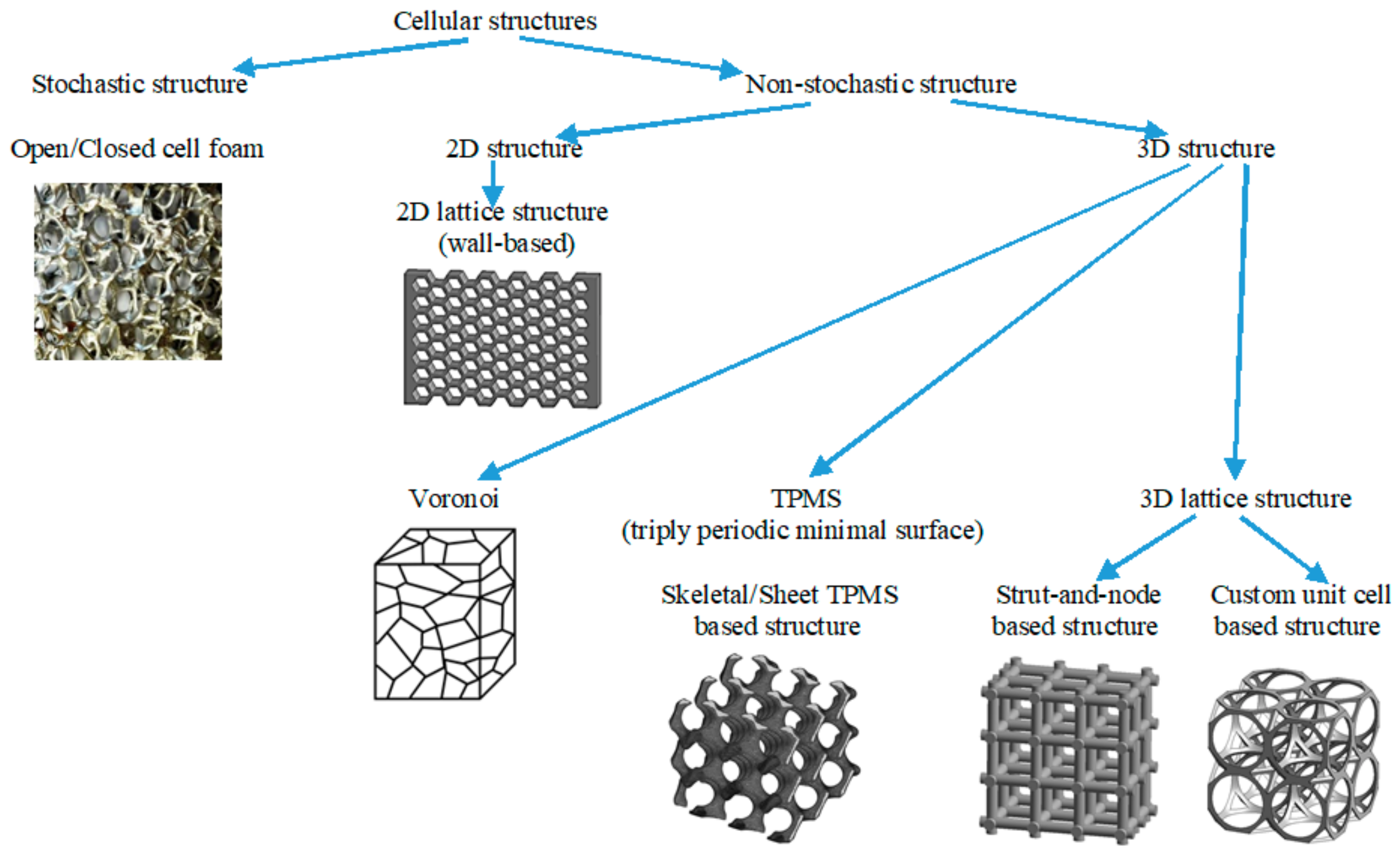
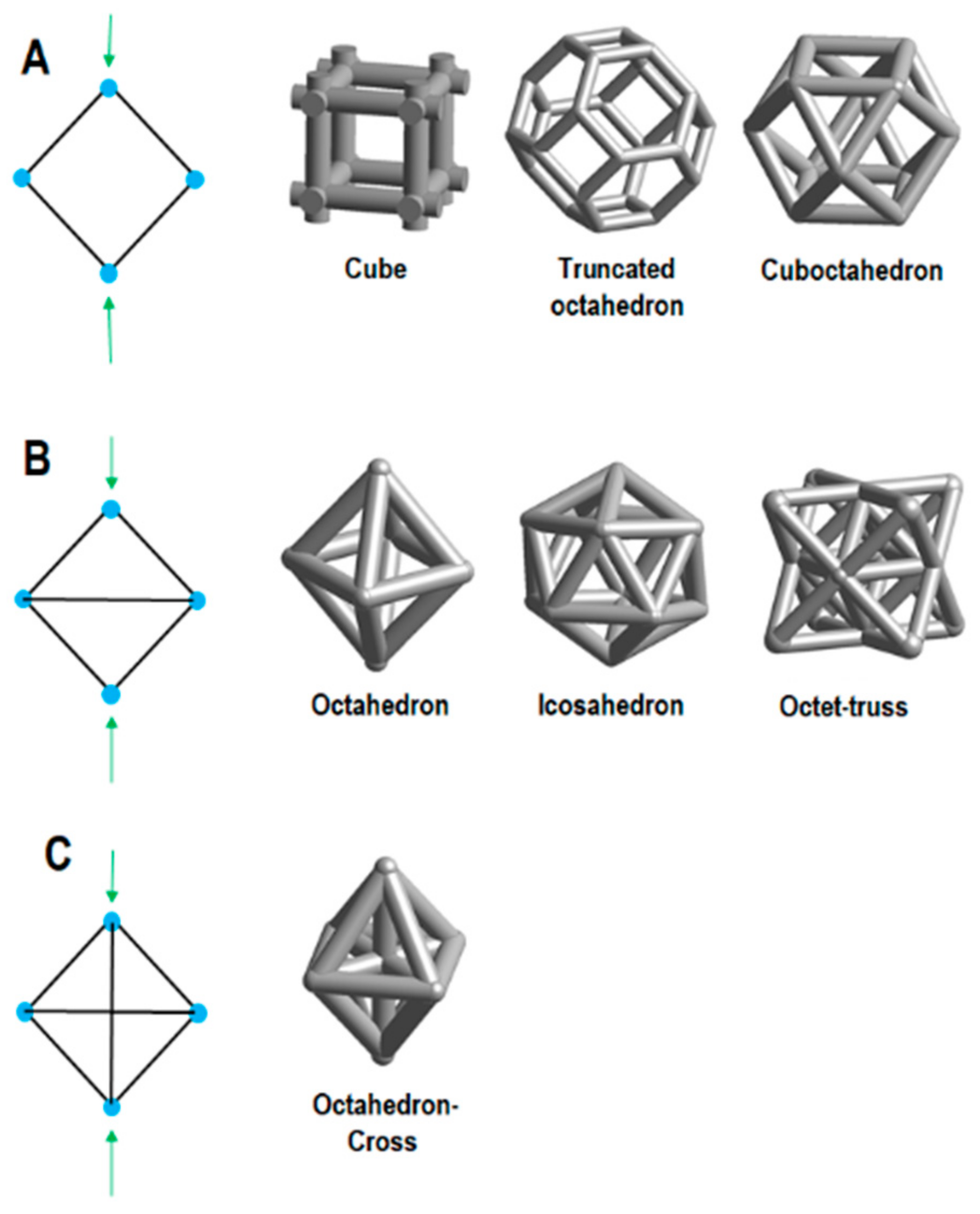

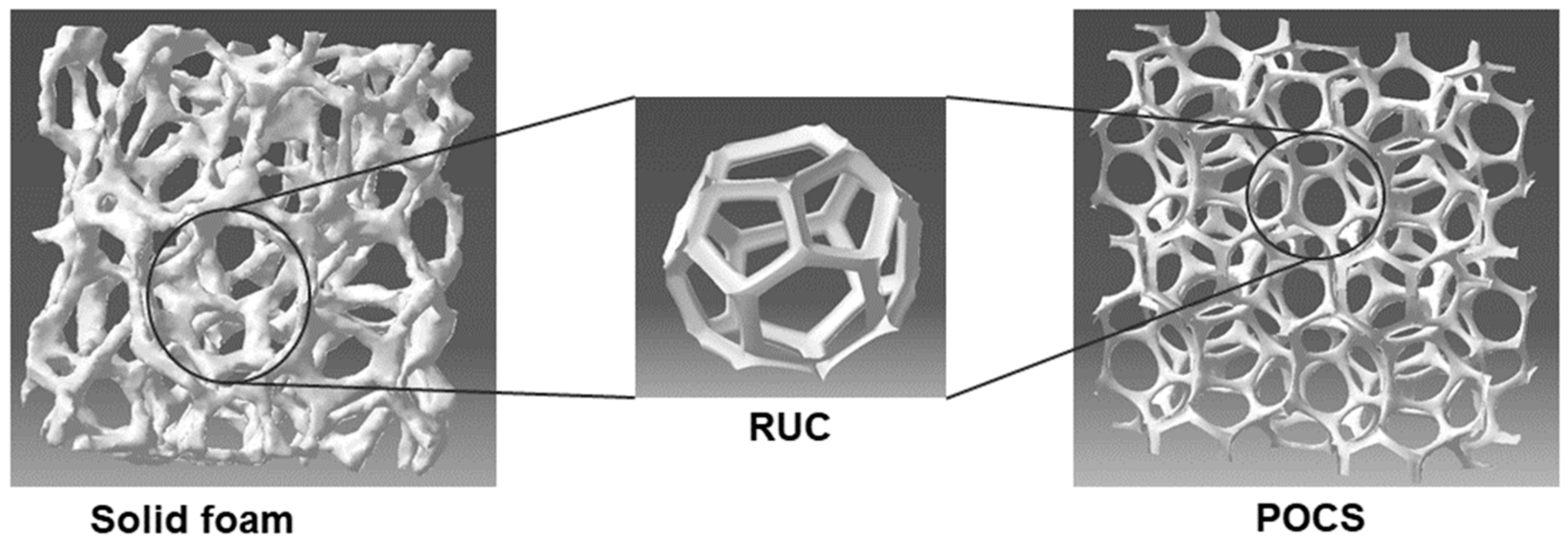
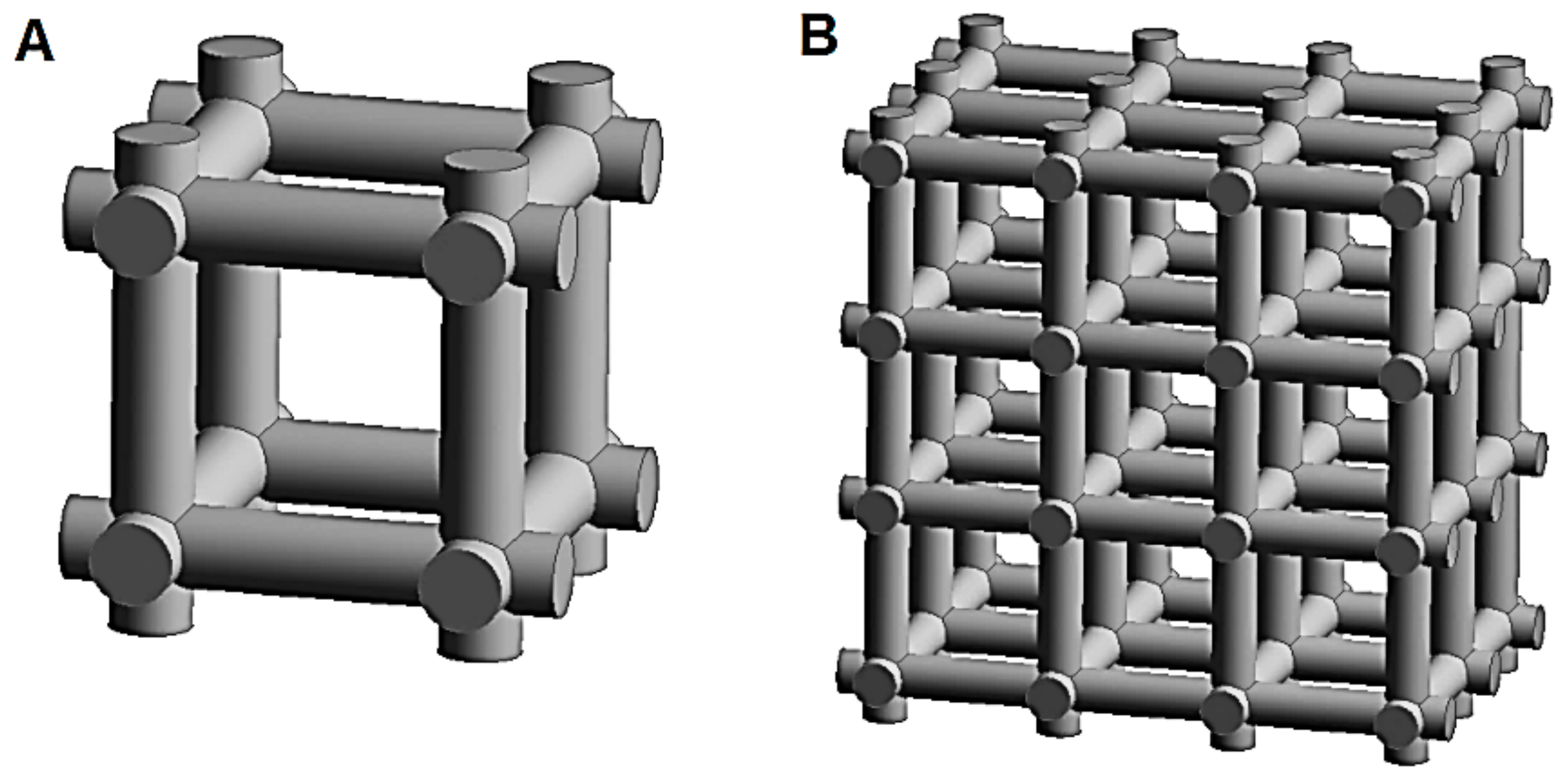

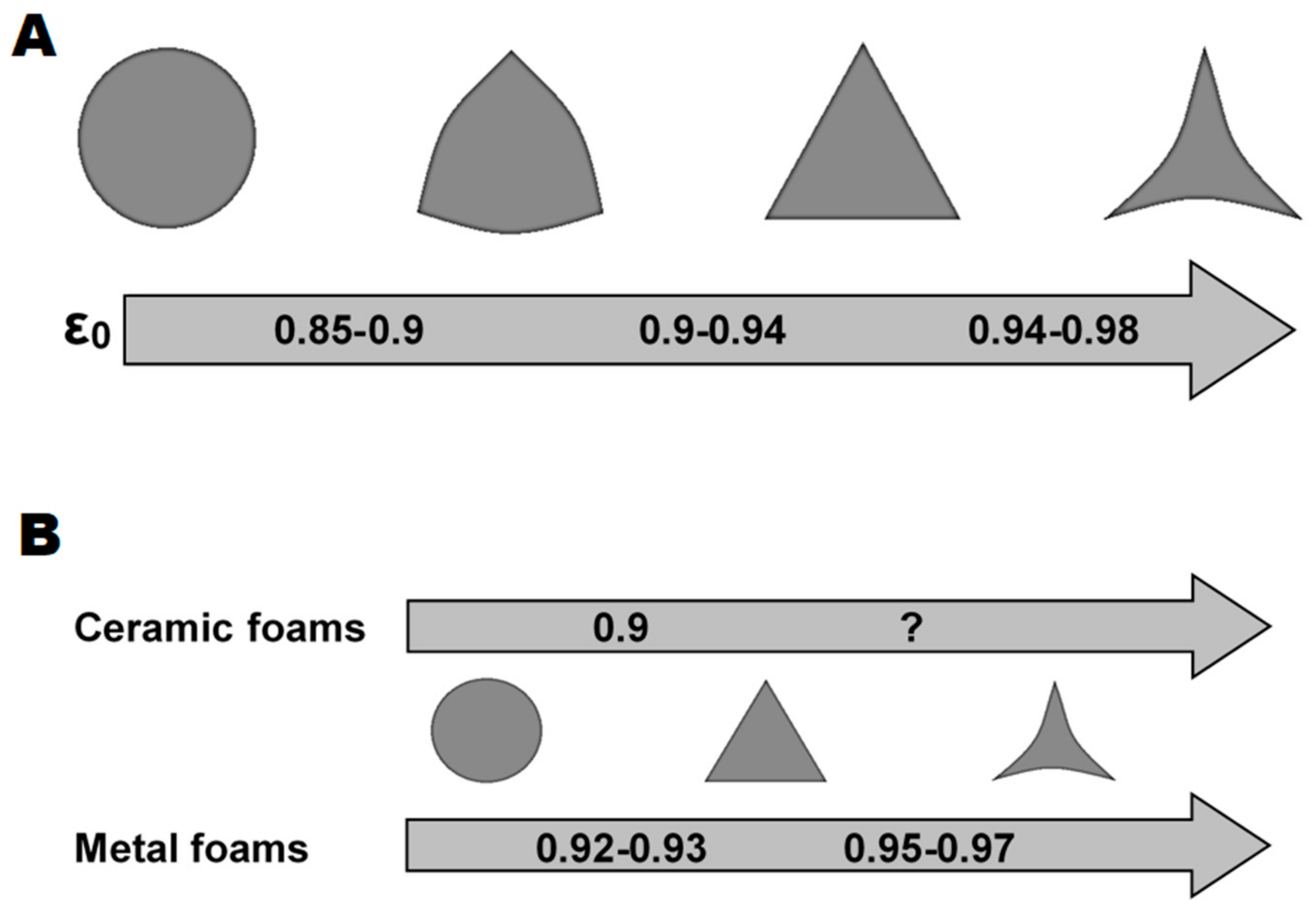
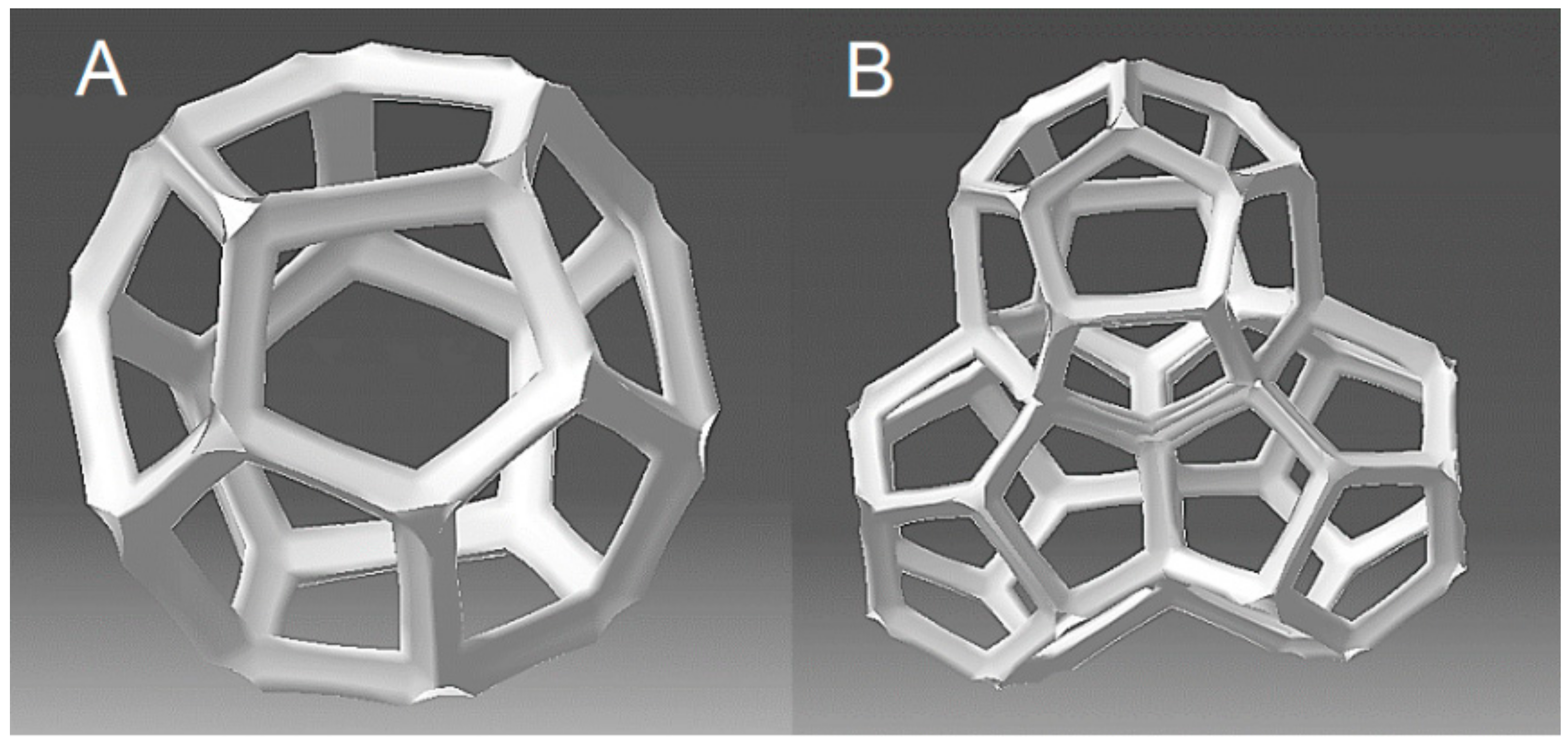
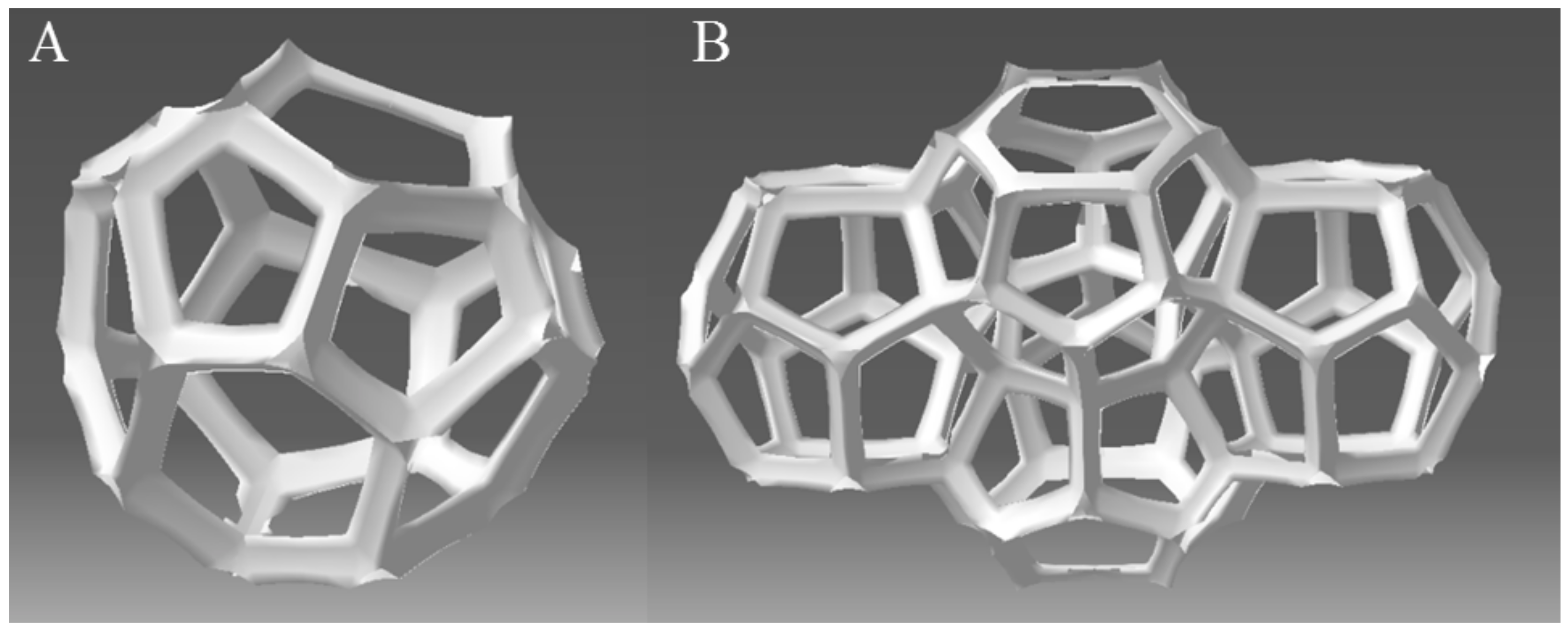
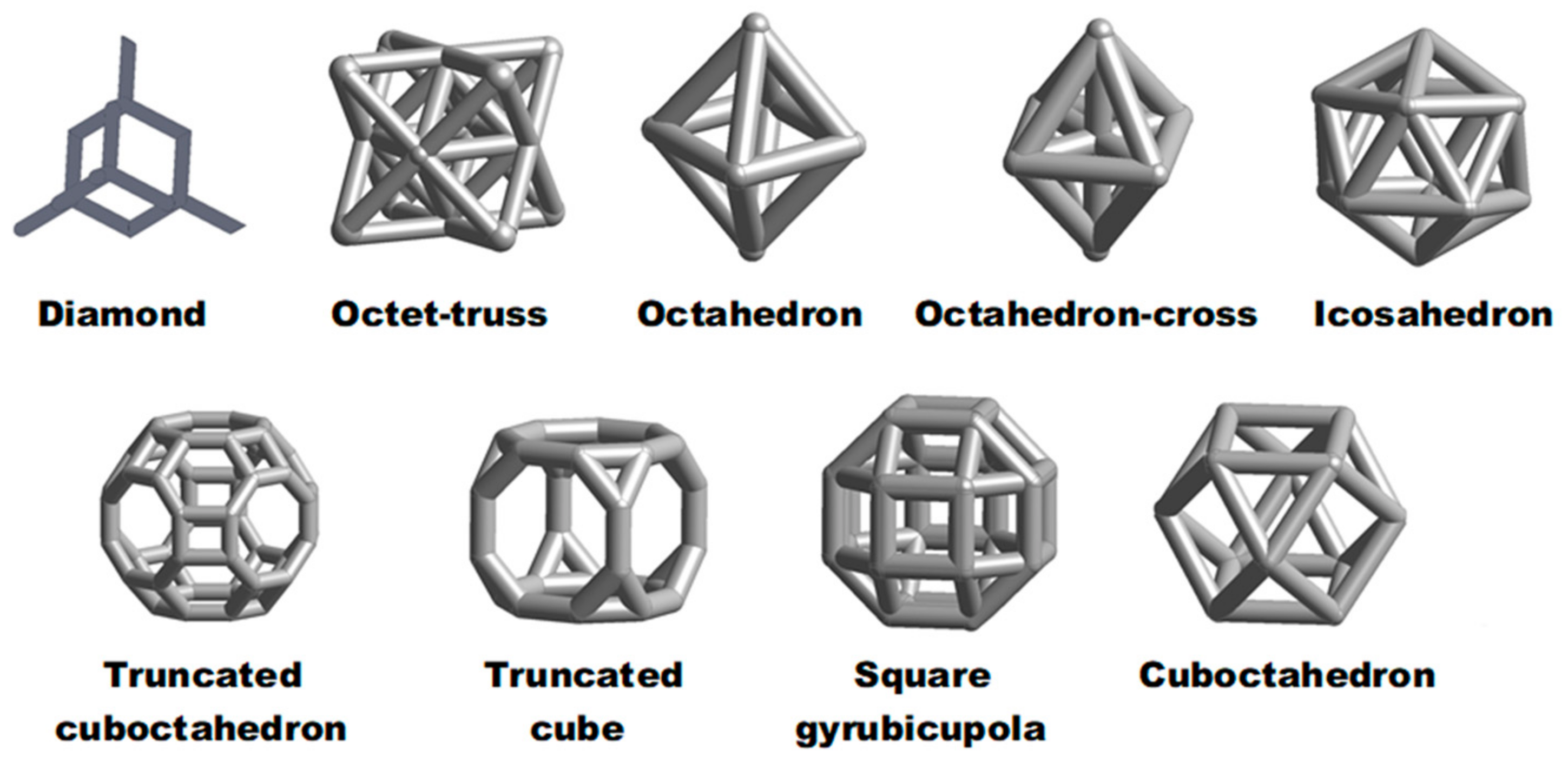


| Unit Cell of POCS | Process | Research | Reference |
|---|---|---|---|
| Cubic Cubic rotated by 45° Kelvin | CH4 oxidation | CFD | [41,55] |
| Cubic | CO oxidation CH4 oxidation HC oxidation | CFD EXP | [56] |
| Cubic Diamond Kelvin | Sabatier reaction | EXP | [85,86] |
| Cubic | CO oxidation | EXP | [87] |
| Diamond | C2H6 hydrogenation | EXP | [88] |
Publisher’s Note: MDPI stays neutral with regard to jurisdictional claims in published maps and institutional affiliations. |
© 2022 by the author. Licensee MDPI, Basel, Switzerland. This article is an open access article distributed under the terms and conditions of the Creative Commons Attribution (CC BY) license (https://creativecommons.org/licenses/by/4.0/).
Share and Cite
Iwaniszyn, M. Periodic Open Cellular Structures (POCS) as Catalyst Supports—A Review. Energies 2022, 15, 7703. https://doi.org/10.3390/en15207703
Iwaniszyn M. Periodic Open Cellular Structures (POCS) as Catalyst Supports—A Review. Energies. 2022; 15(20):7703. https://doi.org/10.3390/en15207703
Chicago/Turabian StyleIwaniszyn, Marzena. 2022. "Periodic Open Cellular Structures (POCS) as Catalyst Supports—A Review" Energies 15, no. 20: 7703. https://doi.org/10.3390/en15207703
APA StyleIwaniszyn, M. (2022). Periodic Open Cellular Structures (POCS) as Catalyst Supports—A Review. Energies, 15(20), 7703. https://doi.org/10.3390/en15207703






